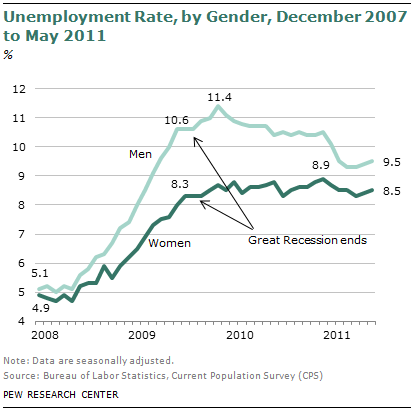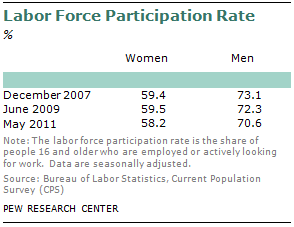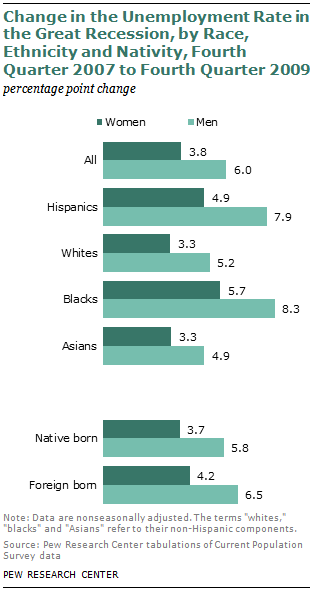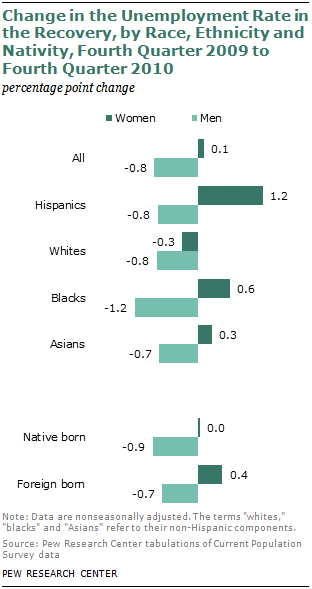Changes in the unemployment rates for men and women during the recession and recovery are consistent with changes in employment levels. At the beginning of the recession, in December 2007, the unemployment rates were virtually equal for men (5.1%) and women (4.9%). During the recession, the unemployment rate for men rose more sharply, rising to 10.6% by June 2009, compared with 8.3% for women.

The first two years of the recovery have failed to reverse the increase in the unemployment rate for women. Indeed, with some fluctuations, the unemployment rate for women continued to increase for more than a year, peaking at 8.9% in November 2010. As of May 2011, the rate had edged downward to 8.5%.
The unemployment rate for men peaked at 11.4% in October 2009. Since then, it has been mostly on the decline. In May 2011, the unemployment rate for men stood at 9.5%, nearly two percentage points less than its peak in October 2009.
The changes in the unemployment rates for men and women largely reflect trends in employment during the recession and recovery—women lost fewer jobs in the recession but only men have regained jobs in the recovery.
Another influence on the unemployment rate is labor force participation. If an unemployed person stops actively looking for work, that person is no longer counted as a member of the labor force or among the unemployed. That can serve to lower the unemployment rate without there being an increase in employment. Conversely, as more people choose to enter the labor force and actively look for work, that can boost the unemployment rate even though there has been no reduction in employment.

Did differences in labor force participation among men and women lead to differences in how their unemployment rates have changed over the recession and recovery? During the recession, there was no change in labor force participation among women—59.4% of working-age women (ages 16 and older) were employed or looking for work in December 2007, and 59.5% were similarly engaged in June 2009. Thus, a change in labor force participation is not a factor in how the unemployment rate for women rose in the recession. The labor force participation rate for men did drop somewhat over the course of the recession—from 73.1% to 72.3%. That may have dampened the increase in the unemployment rate for men during the recession.
During the first two years of the recovery, labor force participation rates have fallen for both genders—from 59.5% to 58.2% for women and from 72.3% to 70.6% for men. Thus, there is no notable difference in labor force activity among men and women that might serve to explain why, in the recovery, unemployment rates for men and women have behaved differently.
Changes in the Unemployment Rate by Race, Ethnicity and Nativity
Gender trends in the unemployment rate transcend race, ethnicity and nativity. During the recession, the unemployment rates of men—whether Hispanic, white, black, Asian, native born or foreign born—increased more than those of women of similar race, ethnicity and nativity. For example, the unemployment rate for Hispanic men increased 7.9 percentage points from the fourth quarter of 2007 to the fourth quarter of 2009, while the rate for Hispanic women increased by 4.9 percentage points. 8The gender gap was highest among Hispanics and blacks and lowest among Asians.

The recovery has proceeded uniformly for men across race, ethnicity and nativity—all have experienced drops in the unemployment rate. The greatest decrease was for black men, whose unemployment rate fell 1.2 percentage points in the recovery. Black men had also the greatest increase in the unemployment rate during the recession.

Among women, only white women experienced a decrease in the unemployment rate in the first two years of the recovery—the rate continued to increase for Hispanic, black and Asian women. The greatest increase was for Hispanic women—1.2 percentage points. The unemployment rate for native-born women was virtually unchanged in the recovery, but it increased 0.4 percentage points for foreign-born women.




